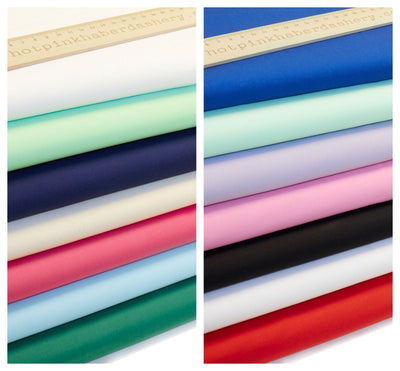The History of Denim - From Workwear Staple to Wardrobe Icon
What Is Denim?
Denim is a strong, woven twill fabric made from cotton. The twill weave consists of two yarns woven in a diagonal ribbing pattern, which differentiates the fabric from other woven cottons like canvas or cotton duck. Combined with strong cotton yarns, this weave creates denim’s characteristic durability.
What Is Denim Made Of?
If you're wondering "how is denim made?"... read on to find out the process of making this classic fabric and what denim is made of.
To start the denim-making process, cotton fibres are spun into yarns. The warp yarns are dyed whilst the weft yarns are usually left white and undyed. Originally, denim yarns were dyed indigo using a natural dye extracted from plants. Today, synthetic indigo dyes are used for classic denim blues, whilst sulfur dyeing produces black and a rainbow of colourful denim tones.
To make the warp-facing twill fabric, the weft yarns run horizontally under two or more of the warp yarns, which run vertically. This means the indigo-dyed warp yarns are more prominent on the top side of the fabric, producing denim’s iconic indigo colour and texture. The weft yarns are traditionally left undyed, which leaves a lighter side to the back of denim fabrics. Light-weight denims usually run the weft under two warp threads, then over one thread.Heavier weight denims use a more dense 3 x 1 twill weave, meaning each weft passes under three warp threads, then over one warp thread.
Who Invented Denim?
The history of denim begins in the French city of Nîmes, where the fabric was originally manufactured and named the serge de Nîmes. Once the cotton twill was exported overseas, it is widely believed that it became known as “denim”, an anglicized version of “de nim”, lending a little French prestige to the new fabric.
Denim’s popularity grew in America, alongside the industrial growth of the nation. As a hard-wearing, durable fabric, denim acted like a worker’s armour for tough, manual labour. From cowboys roping cattle to labourers toiling on machinery and building sites, denim became the everyman’s protective clothing against outdoor elements and the mechanical dangers of work.
When Were Denim Jeans Invented?
During the Gold Rush of 1853, an enterprising immigrant called Levi Strauss opened a shop in San Francisco selling dry goods, alongside threads, buttons and wholesale fabrics. Strauss saw an opportunity with the local mining workforce and began producing hard-wearing canvas overalls and trousers, with large pockets to hold gold, that could withstand the rigours of mining work. He imported a durable cotton twill from France, called serge de Nîmes, and this became the new workwear fabric. One of Strauss’ customers, a local tailor called Jacob Davis, added copper rivets to the seams and pocket corners of Strauss’ denim workwear, to strengthen and hold the clothing where it was most under stress. Together, the two men patented their design and Strauss began mass producing their denim workwear range. In 1880, Strauss created the denim jacket and the following decade he developed his famous 501 denim jean style, the product that would become a wardrobe icon. At the same time, Strauss and Davis’ original patent ended allowing other manufacturers to start producing their own versions of the denim jean. By the early 20th century, brands such as Wrangler and Lee had become established and during the first world war, Lee Union–Alls were standard issue for all war workers. Other denim products started to be produced as well, such as the denim shirt made by Miller & Co in Denver.

How Did Denim Become Popular?
After becoming the working man’s fabric of choice, denim evolved to even loftier heights. The golden age of cinema in the 1920’s and 30’s launched denim onto the silver screen, being worn by cowboy heroes such as Gary Cooper and John Wayne. Publicity photos of movie stars Ginger Rogers and Carole Lombard wearing jeans romanticised the clothing into a casual, glamorous look with US Vogue calling the style “Western Chic”. In 1942, ready-to-wear designer Claire McCardell sold over 75,000 of her denim wrap dress.
However the following decade, Hollywood and rock n’roll evolved the perception of denim once more. Worn by rebellious icons like James Dean, Elvis Presley and Marlon Brando, denim’s appeal shifted to a new, younger audience. Think of Paul Newman in Cool Hand Luke or John Travolta in Urban Cowboy, looking effortlessly cool in their denim shirts and jeans.
American youth adopted denim as symbolic of an anti-establishment mindset, revolution and coolness. During the ‘60s and 70’s, denim continued to play its part by representing social change across the States. Hippies and anti-war protesters wore jeans to symbolise their support for the working class and later, jeans were worn by feminists to reflect gender equality. This cemented denim as an emblem of counterculture and so the iconic denim jean was banned from schools across America. Surely the ultimate accolade for a symbol of rebellion!
The glamour of the late ‘70’s and early ‘80’s, brought denim back into the mainstream being worn by the Studio 54 set and with Calvin Klein being the first designer to show blue jeans on a runway. Other designers soon followed suit, leading to iconic advertising campaigns, such as Brooke Shields in her Calvins and Claudia Schiffer’s sultry shots for Guess. Today denim jeans belong to all parts of society – whatever your age, your job or your budget, you will no doubt have some denim in your wardrobe! Yves Saint Laurent summarized the enduring appeal of denim jeans, when he told New York magazine: “I have often said that I wish I had invented blue jeans. They have expression, modesty, sex appeal, simplicity — all that I hope for in my clothes.”
Fashion and style icons continue to evolve, however denim remains the symbol of casual & cool. The style of denim jeans may shift – from bootcut to skinny to boyfriend, the cut of a denim jacket or a denim shirt may change but the fundamental choice of fabric remains the same – quite simply because denim is always cool.
What Can I Make With Denim?
With different weights, washes and colours to choose from, denim is used for a huge variety of clothing, craft and accessories, not to mention soft furnishings and upholstery. Heavier weighted denims, such as our 8 oz denims, are great for overalls, denim jeans, jackets, skirts, denim shorts and bags, whereas lightweight fabrics, like our 4 oz denims, are perfect for dresses, aprons and shirts. Want to add a splash of colour to your project? Check out our beautiful range of yarn-dyed stretch denim, in a selection of stunning colours and woven with a little stretch for extra comfort. If you fancy adding a new denim piece to your wardrobe, but not sure where to start, our new Tilly & the Buttons sewing patterns are here to inspire and guide you! Here are some denim project ideas to get you started:
- Denim shorts – a pair of denim shorts is a classic wardrobe piece that you'll wear for years. As denim is a durable fabric, your denim shorts will stand the test of time! Try our fab Tilly and the Buttons Jessa shorts sewing pattern to make your denim shorts. Your shorts would look great in a classic blue denim with a breton stripe top or tee or pick one of our beautiful yarn dyed denim fabrics, to add a splash of colour!
- Denim dress – a denim dress is a sure winner when it comes to combining style and comfort. It is easy to wear and style for different occasions – so you'll never get bored of your favourite denim dress! Looking for some dressmaking ideas? Check out our Lyra shirt dress sewing pattern, that will look perfect with our denim or chambray fabrics.
- Denim shirt – The denim shirt may have been around for 100 years, but it remains a statement fashion piece that always looks cool! Tilly & the Buttons Rosa shirt sewing pattern would be perfect for your new denim shirt. Wondering what to wear with a denim shirt? Wear your denim shirt with denim jeans for a denim on denim look, combining different washes or with white or black denim jeans for a really striking outfit. Wear your denim shirt to work, by adding a french tuck and a pencil skirt or for your summer holiday with a pair of shorts.
Can You Wear Denim On Denim?
Denim on denim is a great look – you just need to select complementary washes to make a striking outfit. Here's just a few ideas on how to wear denim on denim:
- Combine a denim or chambray shirt with blue, white or black denim jeans. Add a french tuck to the shirt for effortless cool.
- Wondering what to wear with a denim jacket? The denim jacket is another wardrobe favourite that is easy to wear and style with different looks. Sling a denim jacket over your denim jeans – try different blue washes or a white or black denim jacket over your blue denim jeans. Also, try a denim jacket over a chambray dress, combining different textures & blues for a cool, denim outfit.
What Is Chambray Fabric?
Our beautiful chambray fabric range is a lighter weighted, softer version of denim, ideal for summery shirts, dresses and skirts for both adults and children as well as soft furnishings like cushions and curtains.
Chambray is a plain-weave fabric, usually made from 100% cotton. Chambray fabric combines a coloured yarn in the warp and a white yarn in the weft. Classic chambray is most recognised by its light-blue tone, making it look similar to denim. However, there are a great range of yarn-dyed chambray colours to choose from – combining the soft, light drape of 100% cotton chambray with the soft tones of this plain weave chambray fabric.
When selecting your denim and chambray fabric, don’t forget we also supply zips, specialist denim threads, hardware and machine needles so you have all the tools you need to finish your project!
We always love to see our customer’s creations, so please share your projects with us on our Instagram!








Leave a comment